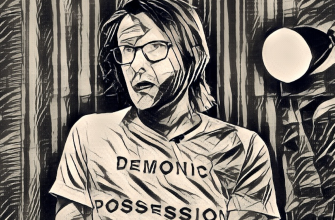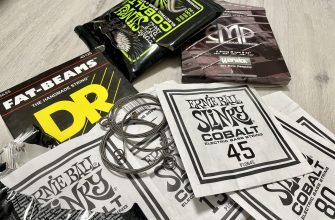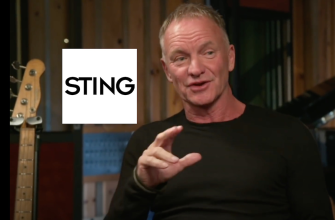I’ll tell you about my experience with picking and playing the bass part, as well as my general impressions of the song Fall Into Sleep from the third studio album Lost and Found (2005) by Mudvayne.
- General points
- Bass tab and sheet music
- Training materials
- Song parameters
- Bassline, how to play
- Intro
- Verse 1 – 5th bar, 00:13
- Pre-Chorus – Chorus – 13 bar, 00:39
- Verse 2 – 25 bar, 01:18
- Pre-Chorus – Chorus – 33 bar, 01:45
- Bridge – 43 bar, 02:18
- Pre-Chorus – Chorus – 51 bar, 02:44
- Outro – 62 bar
- Bass sound
- Other musical instruments
- Drums, Matthew McDonough
- Guitars, Greg Tribbett
- Vocals, Chad Gray
- Lyrics meaning
- Summary
General points
Fall Into Sleep sounds more mainstream compared to the band’s earlier material and other songs from the album. But it’s all within the Mudvayne style, only put together with a more popular and simple structure. Actually, the clear form makes this song one of the most popular in the band’s repertoire.
As for the most interesting parts of the song to me, I would single out the verse. First one was memorable for me first of all thanks to the bass part. The second verse sounds very energetic, starting from the 29th measure (1:34). The bridge of the song (from the 43rd measure, from 2:20) is also very cool.
Bass tab and sheet music
First I will pick up the bass part and then see how it interacts with the rest of the instruments.
Training materials
https://www.songsterr.com/a/wsa/mudvayne-fall-into-sleep-bass-tab-s13193 – here, in my opinion, are quite adequate tablature. There are some small nuances, which I will tell you about below. The second version I found here https://www.mediafire.com/file/aqrolqr1mdccaao. It can be downloaded and printed, if it is more convenient to work that way. It has grace notes in the bridge, but in the song I hear more like the regular 16s.
Song live performance at Mudvayne live Big Day Out 2006 show in Sydney (26.01.2006). https://www.youtube.com/watch?v=k_U1Ehpt3ow This is primarily to hear the missing nuances. Overall the performance sounds like a studio recording, no new arrangements have been made by them. They play without a metronome, you can hear the tendencies to slow down on the pre-choruses, and to speed up on the choruses. On average, slightly slower than on the record. Chad Gray doesn’t hear himself well, he has trouble monitoring on stage, you can see that it makes it hard for him to sing. I want to warn you, that this is not a modern and cleaned concert recording, but it’s real without a lot of playbacks. And the energy of a live performance lets you feel it. I really love the tight guitar-bass-drums-vocal lineup in metal.
Of the bass covers I chose 7slot https://www.youtube.com/watch?app=desktop&v=6zim3W4f8WY He doesn’t play 100% accurately, adding extra chips from himself to the part, but in the style of Rayan Martinie. Overall, though, he has a great playing style.
Song parameters
Tempo ♩=73.
Tuning – CGCF. F-first string. Drop C tuning.
Key C minor.
Time signature – 4/4.
Bass player Ryan Martinie needs no introduction.
4-strings Warwick Thumb Bass NT.
Bassline, how to play
Let me tell you right away that the bass part is not very complicated, it may well be suitable for not very experienced musicians. To begin with, some parts with 16 notes should be played under the metronome slowly in several approaches in several days, until they become natural to the brain. There are no complicated rhythmic patterns here, rather nuances to pay attention to. Plus a small tempo. So if you are looking for where to start learning metal, this is a very good choice, even if it doesn’t sound like it at first.
Ryan Martinie often uses glissando, slides between notes. When repeating it, it is important not to get out of tempo. It is better to play without it at first, and then to add features of articulation. A bad slide sounds worse than no slide.
I try to look at the bass part in the context of the song, how it fits in with the rest of the instruments, what role it plays. So I also work through the guitar parts. Most of the time I don’t play it perfectly, I try to see which chords and which riffs are played. The same goes for the vocal parts.
Intro
The bass comes in later. Clean guitar plays a riff that runs through the entire song as a pre-chorus. It’s B♭-C against the sounding C note, a rock classic. Next comes the C+C octaves. You can play this part on the bass on the 1st – 2nd string. I wouldn’t duplicate with the guitar when playing a cover, but for the sake of understanding why not.
Verse 1 – 5th bar, 00:13
The bass comes in. This is a playback of the chord sequence: Cm is repeated several times – A♭ – E♭5 – F5 (I – VI – III – IV). In this case, the guitar plays an exactly repeating pattern, while the bass is unique in each measure. And when a chord is changed, the bass doesn’t just transpose it, but plays it a little differently. So it’s interesting to listen to the verse, it doesn’t get boring. The part consists of 16 notes without pauses in which there is a melody, not only rhythm.
If you are new to playing the bass, do not be intimidated by the complexity of the part. It sounds harder than it is played. If you can not do it the first time, then on the fragments under the metronome learn at a slow tempo. After a few days of 30 minute lessons you should be able to play at a real speed.
I play the guitar part, too, to understand better the pulsation and interaction of musical instruments.
I’ll note the drums. Take a listen. The snare drum is slightly syncopated at first, and flat in the second half of the verse.
Pre-Chorus – Chorus – 13 bar, 00:39
I love pre-choruses in songs as they prepare for the chorus. The chorus itself is based on both the riff and the I – III chord movement, and the three-note grouping at the end. Such groupings run through the entire song. If you follow the guitar part closely, there’s this rhythmic movement everywhere, both in the verse and in the bridge.
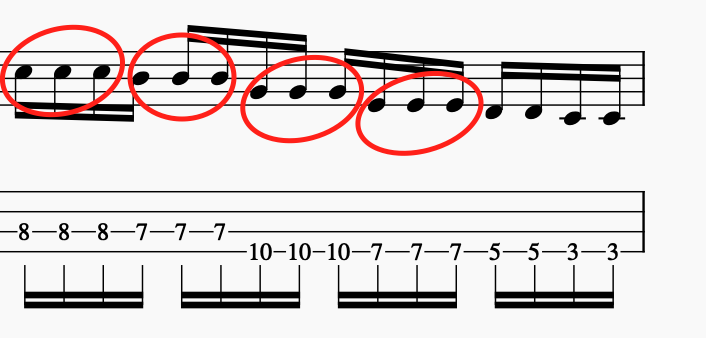
The chorus, while seemingly simple, contains many musical elements: pauses, slides, 32nd notes, bend. Technically they are not difficult to perform, but they make the song more lively.
Verse 2 – 25 bar, 01:18
The guitar continues the theme of the first verse, only with overdrive and palm muting. In the second part of the verse, the muting is removed. At this point there is a kind of catharsis, which is my favorite part of the song.
In addition to the guitar, the bass makes the tension. The first part is purposely more rarefied, with a little unexpected pattern with pauses. The brain was waiting for the part like in verse 1. Finally the brain gets it in the second part. Only it is played with more attack, presumably closer to or on the fingerboard.

In addition to the aggression in play, I’ll add a note about hearing extra slides to the C note. As in the second version of the sheet music.
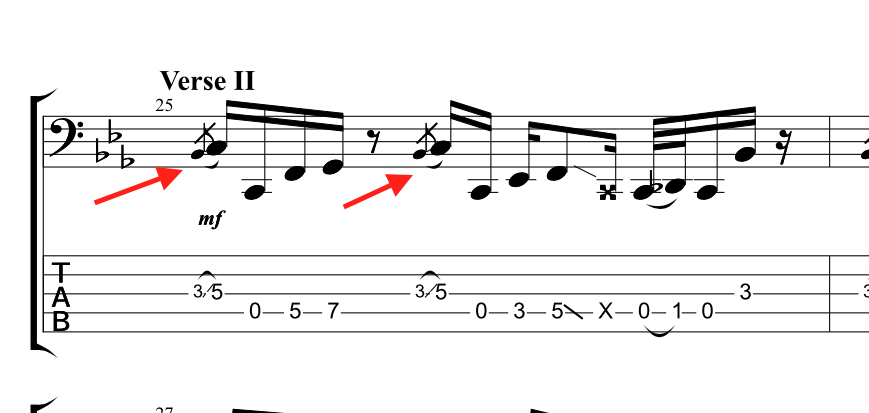
28 bar I hear easier rhythmically than in the taken tablature examples. See photo.
Pre-Chorus – Chorus – 33 bar, 01:45
The instruments and vocals are played the same way as the first time, except for the drums. Take heed, Matthew McDonough plays some interesting new fills.
Bridge – 43 bar, 02:18
Let’s listen to the demo version of the song, which is published on By The People, For The People. You can hear that the bridge is the only part of the song that is replaced with a new one. Why was such a production decision made? I don’t know exactly, but it’s important to note and reflect. Perhaps it adds melody to the song and is the grain that brings it closer to success.
The bass part at this point is as varied as ever and not repeated in any one measure entirely. It is melodic. For more understanding, try playing the guitar part as well. It is simple, but beautiful. If you don’t have a guitar, you can play it on the bass.
Chad Gray adds a high G note to the part in the second part of the bridge, while still using screaming. This is his signature sound, which I like very much.
Pre-Chorus – Chorus – 51 bar, 02:44
I think Ryan Martinie would die of boredom if the chorus was repeated without changes.
I see variations in the bass guitar part, especially in bar 57.
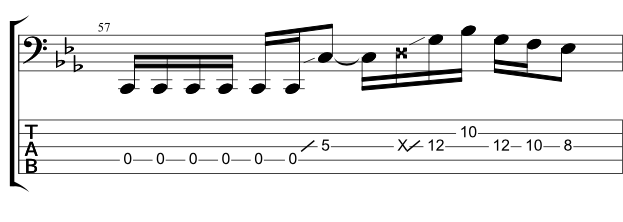
In addition, the pauses in the chorus disappear and the 60th measure 3/4 is added. It sounds unusual compared to the rest of the song in 4/4.
It also seems to me that when recording the last chorus, Mudvayne turned off the metronome or flew out of it and left it that way.
Outro – 62 bar
The bass part is from the verse, but something is wrong. Yeah, the C guitar plays the line from the pre-chorus. Such an unexpected combination. The pleasant sound of the bass is best heard in this piece.
At the end of the song it is important to practice the bass guitar part so that it really sounds like metal. I record a bass playthrough and listen to what comes out. It’s the best way to hear and correct your mistakes.
Bass sound
No special pedals needed, that’s what I like about Ryan Martinie. Maybe just add a compressor and EQ if you want. It is important to rehearse an aggressive attack. It’s the style of playing that creates the recognizable character of the sound, not the gear. Although a Warwick Thumb would be a good addition.
Other musical instruments
Drums, Matthew McDonough
The drums sound natural, without the sampling replacements usual for modern music. This is especially noticeable with the cymbals and the hi-hat. And in general, they sound as if they were live, not typed in an editor. This has its own charm.
Guitars, Greg Tribbett
What I like about the guitar is that it leaves room for the bass. That’s probably one of the important things that makes Mudvayne’s music the way we like it. All in all, the music is lively, you get the impression that a lot of things were rehearsed by the whole band before the recording.
Vocals, Chad Gray
I play the main parts of the vocal part on guitar or sing along in falsetto to understand what’s going on. Chad’s vocals are too high for me. What I should note, he can use screaming strongly and beautifully in a rather high range. Of the technical stuff, the song uses a whisper.
Lyrics meaning
The meaning of the song is quite abstract, which is logical for nu-metal. I refreshed my memory with the music video. It tells a sci-fi story with aliens. Then it’s kind of like a dream, but you can tell from the last frames that it’s kind of not. It’s a technique often used in 2000s movies about all sorts of monsters that are destroyed, but the audience sees at the end that not all of them are. But I wouldn’t strongly associate the meanings of the song and the video.
The song is broader in meaning, the author, when writing it, could even think in terms of just images, to convey emotion. A music video is first and foremost a tool to introduce the listener to the song, to get through to him. After that he is free to make up his own meanings, if they are not understood unambiguously.
For me personally, the song paints vivid images. It is sad in the lyrics, but it doesn’t make you feel sad because of the energy of the metal. Evening and falling asleep is a time for reflection. Then a clear border of reality is lost. For me, the song is about that state. In the morning everything will be easier. And so it is every time.
Technically the song has a lot of repetition of the opening words of the lines: dreams, no more. They make a skeleton on which the other images are strung.
Summary
The song is very lively, it doesn’t have identical choruses and verses. It’s the same in the studio version as it is in live. It’s just made up live on four musical instruments. There’s a big rhythmic strat of guitar with strict repetition through the song, and the bass and drums do little deviations, keeping you from getting bored.

